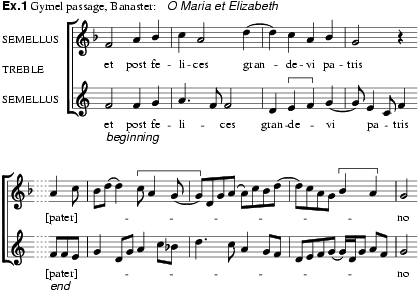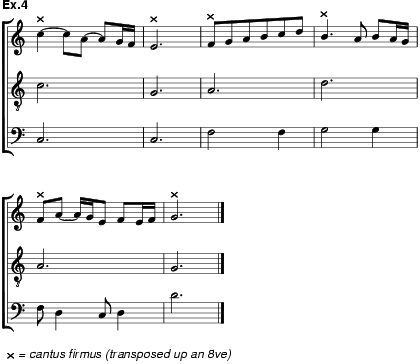
A 15th- and 16th-century English term denoting the counterpoint that results from the temporary splitting of one voice part in a polyphonic composition into two voices of equal range. Each of the two voices so produced is usually designated as ‘gymel’ in the manuscript sources. The evident etymological derivation of the word from the Latin gemellus (‘twin’) is corroborated by John Palsgrave, who in the English–French vocabulary of substantives in book 3 of his Lesclarcissement de la langue francoyse (London, 1530) gave iumeau as the French equivalent of ‘Gymell song’.
While the term ‘gymel’ seems not to have come into use before the later 1430s, the first known example of the practice dates from the mid-14th century (GB-DRc C.1.20, ed. in PMFC, xv, 1980, no.34). The case is the more remarkable for the periodic occurrence of gymel in the triplum of an isorhythmic motet, a species rightly assumed to have involved performance by only one musician to each part.
In the 14th century there was a widening of the two-voice framework to more than a single octave, and a regular acceptance of the 12th as the largest contrapuntal interval between the outer voices of a composition. This brought with it the gradual development of a concept of polyphony in which the voice parts tend to occupy contiguous rather than identical or largely overlapping ranges. This differentiation of ranges in turn evidently caused English composers to vary the combination of voices within compositions. By about 1400 works came to be written in which duet sections provided textural change as well as structural articulation within a three-part context.
Two factors therefore seem to account for the rise of gymel: (1) The growing interest of composers in a succession of textures and colours, varied from section to section by means of different combinations of voices; and (2) the growth of small but well-trained and properly balanced chapel choirs. The latter were expected by their aristocratic patrons to sing the new sonorous choral polyphony that 15th-century composers were beginning to write for them, in contrast to the ecclesiastical and courtly solo polyphony of earlier times.
Apart from one unusual case, no extant English manuscript before the end of the 15th century contains examples of gymels. That exception is a composition (in GB-Lbl Eg.3307, c1440) whose two sections both begin with a duet for two high voices not labelled gymel, in which the two voices subsequently combine into one before the remaining voices enter. The fragmentary state of preservation of English sources doubtless accounts for the curious fact that the earliest documentation of an English practice and term is found in two continental manuscripts. The tropes in a Sanctus by Roullet (D-Mbs lat. 14274, ff.143v–5) are composed for solo duet using two sopranos, designated ‘gemell’. O rosa bella, attributed to Dunstaple (as it appears in I-TRmp 90), has several additional voices, two of which, labelled ‘Gimel’ and ‘Alius Gimel’ and occupying the same range as the melody, are designed to form alternative duets with it. (The resulting counterpoint makes it impossible to retain the remaining voices of the composition.) In both of these cases the manuscript was probably written in the late 1450s, while the composition may well date from about 1440.
The practice of fashioning a gymel for a pre-existing voice part is briefly referred to in an anonymous English treatise written in about 1450, the so called Pseudo-Chilston. After enumerating unison, 3rd, 5th, 6th and octave as the consonant intervals available to a countertenor improvising a descant above or below a plainsong, the author continued: ‘And alwey beginne and ende thi Countertenor in a 5. And thi Countergemel begynne and ende in unisoun’ (Bukofzer, 1936). The directions are laconic, but entirely adequate in the context, since the ‘countergemel’ (the voice added to a pre-existing part to produce an improvised gymel) differs from a countertenor in nothing but the unison junction with its ‘twin’. (Pseudo-Chilston made it clear that the Sight system of faburden and English discant did not apply to the countertenor; naturally, it would be equally inappropriate for the countergemel.) The counterpoint of the composed gymels for O rosa bella reflects the rules given by Pseudo-Chilston.
The first English source to contain gymels is the Eton Choirbook, written between 1497 and 1502. Compositions in which they occur are by Banaster (MB, x–xii, 1956–61, no.28), Browne (no.5), Cornysh (no.30), Davy (nos.11, 51), Fawkyner (no.32), Horwood (no.44) and Lambe (no.14). In the gymel section of the work by Banaster, who belonged to the generation before the other composers, the treble part is split while all other voices pause (ex.1). Taken together with the earlier cases this seems to indicate that composed gymels originally involved the top part of a composition and excluded all the other voices from participation in the counterpoint. The manuscript uses semel (semell, semellum) as well as the conventional term to designate gymels. This perhaps confirms that no more than two singers usually sang a given voice part. (Semel does not indicate the return to unison singing, as has been claimed.) All other instances of gymel in the Eton Choirbook and in later sources combine such duets with one or more of the other voices, which need not be lower voice parts. Nor do the gymels necessarily any longer begin and end on a unison. Any voice – even the bass – can be split; and sometimes two voices are divided to form double gymels, either by themselves or in counterpoint with one or more of the other parts.

Other manuscripts containing compositions with designated gymel sections are GB-Llp 1 (c1510), Cgc 667 (c1520) and the so called Forrest-Heyther Partbooks (Ob). Representative composers to use the device are Cornysh (Magnificat), Aston (Missa ‘Videte manus meas’), Taverner (Missa ‘Gloria tibi Trinitas’; Missa ‘Corona spinea’; Missa ‘O Michael’), Tye (Missa ‘Euge bone’), Tallis (Gaude gloriosa mater; Magnificat) and Robert White (several compositions). The term seems to have fallen into disuse by the late 1560s. The claim that evolutionary lines can be drawn from gymel to bicinium and from gymel with contratenor bassus to canzonetta, basso continuo duet and trio sonata seems fanciful and dubious, the more so since bicinia were usually not written for equal voices and 16th-century gymels generally shared their counterpoint with a variety of additional voices.
Apart from Pseudo-Chilston, only Guilielmus Monachus, presumably an Italian savant writing in Italy in about 1470, reported on gymel, which, together with ‘faulx-bordon’, i.e. faburden (not ‘English discant’, as has been claimed), he calls the two ‘modi Anglicorum’ (CSM, xi, 29–30, 38–41; CoussemakerS, iii, 228b–289, 292a–295b – corrections by Bukofzer and Trumble). The first passage describes it as an improvisatory technique (notating it as inex.2; the octave transposition assumed by Bukofzer in MGG1 seems based on a misreading of the relevant passages), while the other deals with composed gymel. The only change in Guilielmus’s descriptions is the omission of the 5th from the available consonances. His examples prove that this is not an oversight, since they contain no 5ths, but exhibit long stretches of parallel 3rds, 6ths and 10ths. The incidence of parallel 6ths in particular makes it clear why he discussed faburden and gymel together: his version of the latter, which, according to him, may or may not involve a cantus firmus, often sounds like fauxbourdon without the middle voice. Moreover, he said that in composed gymels it is possible to have a contratenor bassus, ‘because, if indeed Gymel have 6ths and 8ves in the manner of faulxbordon, then the contratenor of Gymel can proceed just like the contratenor of Faulxbordon …’. (In other words, since the usual contratenor altus is impossible in such a fauxbourdon, it is in fact the same as parallel gymel with contratenor bassus, because it has lost the characteristic parallel 4ths of normal fauxbourdon;ex.3.) If the main voice (i.e. the top voice) contains a cantus firmus, the latter will, of course, normally have to be transposed upwards, usually an octave. The prevailing techniques of decoration and paraphrasing are then applied to it (ex.4).


Both the principle of parallelism and the corollary separation of the voices in his composed gymels – there is no crossing of voices between cantus and ‘tenor’ – set Guilielmus apart from the English tradition. Counterpoint for twin voices has been transmuted into parallelism for two different voices, to which the term gymel seems hardly applicable. (The frequently cited ‘Gemel’ in PL-Wu Rps.Mus.58, which involves two unequal voices, likewise betokens a continental misunderstanding of the word.) The situation is similar to the rise of fauxbourdon on the Continent in the later 1420s. Both cases demonstrate how continental musicians assimilated an English contrapuntal technique favouring imperfect consonances and more or less frequent parallel movement, the latter, however, by no means continuous; each time the result was a codification into a system far more rigid than the original style.
The tangled semantic history of gymel in modern musicology is due to the fact that theoretical sources were published first. The earliest discussion of gymel (by Adler) resulted from Coussemaker’s publication in 1869 of Guilielmus’s treatise. Both Adler and, after him, Riemann surmised, not unreasonably, that the parallelism of Guilielmus’s examples, which appeared to be an essential characteristic of gymel, was the original germ of harmony (Adler), the oldest type of English polyphony (Riemann). And indeed, 13th-century English musicians produced a number of duets for equal voices that cross frequently and favour parallel 3rds (see Cantilena (i)). The first to misapply the term gymel to consecutive 3rds in English polyphony (for two or more voices) of the 13th and 14th centuries was Wooldridge in 1905 (OHM, ii). 30 years later Bukofzer published the first of many essays in which he emphatically set forth this interpretation. Though anachronistic and inaccurate, it has been adopted by many authors.
HarrisonMMB
MGG1 (M.F. Bukofzer)
MGG2 (K.-J. Sachs)
Guilielmus Monachus: De preceptis artis musicae (MS, c1480); ed. in CSM, xi (1965)
G. Adler: ‘Studie zur Geschichte der Harmonie’, Sitzungsberichte der philosophisch-historischen Classe der Akademie der Wissenschaften, Wien, xcviii (1881), 789–814
H. Davey: History of English Music (London, 1895, 2/1921/R), 51–2, 83, 90, 132
M.F. Bukofzer: ‘The Gymel, the Earliest Form of English Polyphony’, ML, xvi (1935), 77–84
M.F. Bukofzer: Geschichte des englischen Diskants und des Fauxbourdons nach den theoretischen Quellen (Strasbourg, 1936/R), 149ff
T. Georgiades: Englische Diskanttraktate aus der ersten Hälfte des 15. Jahrhunderts (Munich, 1937), 107
M.F. Bukofzer: Studies in Mediaeval & Renaissance Music (New York, 1950), 145–6, 188
M.E. Lyon: Early Tudor Church Music: the Lambeth and Caius Manuscripts (diss., U. of California, Berkeley, 1957)
E. Trumble: Fauxbourdon: an Historical Survey (Brooklyn, NY,1959), 43–4, 56–7
E. Trumble: ‘Authentic and Spurious Faburden’, RBM, xiv (1960), 3–29
E.H. Sanders: ‘Cantilena and Discant in 14th-Century England’, MD, xix (1965), 7–52, esp. 7–9
E. Park: ‘De preceptis artis musicae’ of Guilelmus Monarchus: a New Edition, Translation and Commentary (diss., Ohio State U., 1993)
ERNEST H. SANDERS